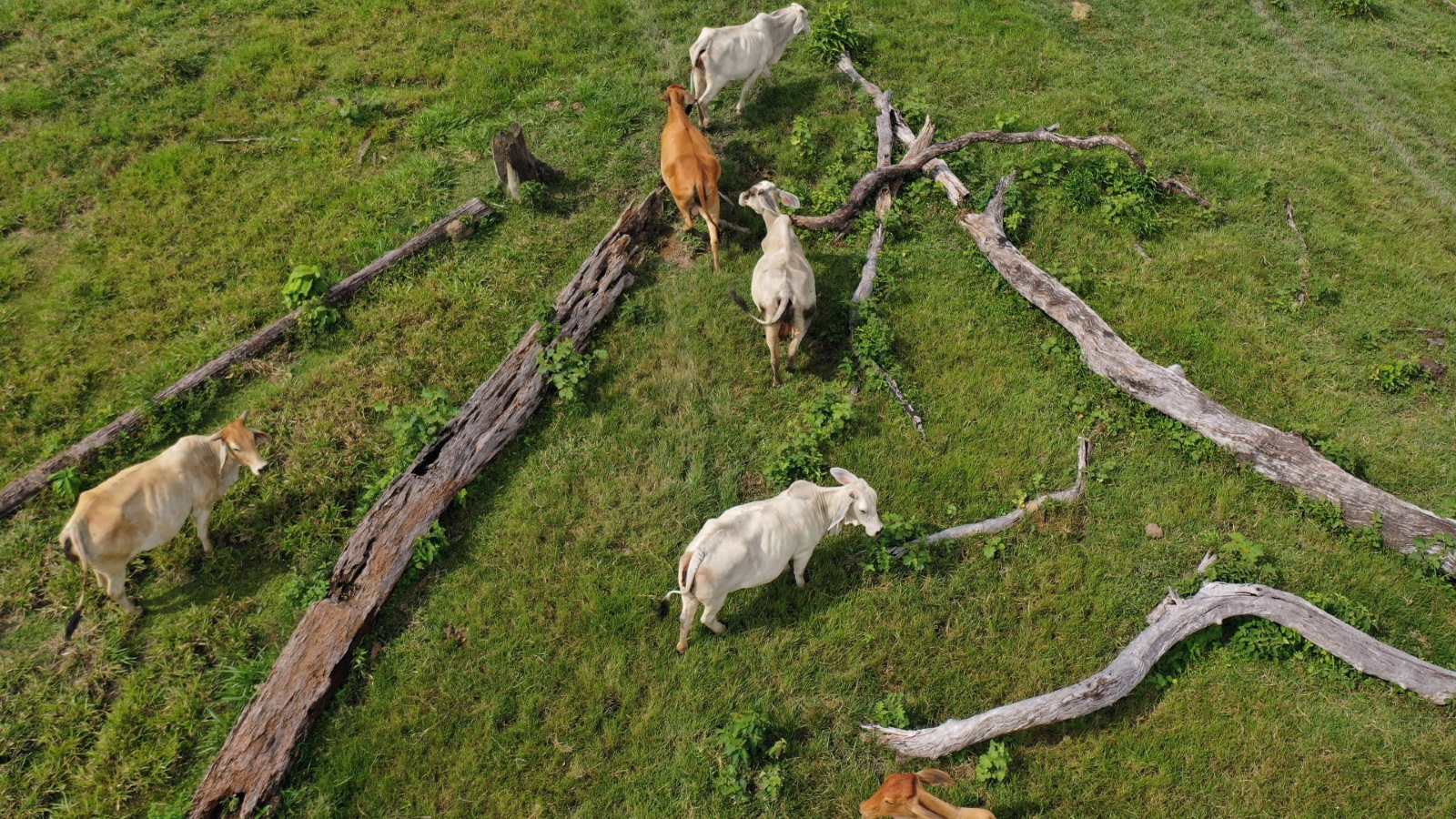Cows are often described as climate change criminals because of how much planet-warming methane they burp. But there’s another problem with livestock farming that’s even worse for the climate and easier to overlook: To feed the world’s growing appetite for meat, corporations and ranchers are chopping down more forests and trampling more carbon-sequestering grasslands to make room for pastures and fields of hay. Ruminants, like cattle, sheep, and goats, need space to graze, and animal feed needs space to grow. The greenhouse gases unleashed by this deforestation and land degradation mean food systems account for one-third of the world’s human-generated climate pollution.
Environmental advocates have long argued that there’s a straightforward solution to this mess: Eat less meat. Convincing more people to become vegetarians is a very effective way to limit emissions. Getting rid of meat is one question; replacing it is another. A paper published on Tuesday seeks to address both, finding that giving up meat in favor of meatlike plant products would yield significant benefits for the climate, biodiversity, and even food security in coming decades.
Swapping 50 percent of the world’s beef, chicken, pork, and milk consumption with plant-based alternatives by mid-century could effectively halt the ecological destruction associated with farming, particularly in sub-Saharan Africa, China, and Southeast Asia, according to the study in Nature Communications. Such a dietary shift could also lead to a 31 percent reduction in agricultural greenhouse gas emissions by 2050, the study found. That’s the equivalent of not burning 1.8 trillion pounds of coal each year between 2020 and 2050.
Climate policies and investment focus heavily on fossil fuels and the energy sector, but slashing agricultural emissions is also crucial to keeping planetary warming below catastrophic levels, said Lini Wollenberg, the study’s co-author.
“There’s enough evidence to show that if we don’t shift our diets, then we will not meet the 1.5 degree Celsius target by 2100,” said Wollenberg, who researches climate change and food systems at CGIAR and the University of Vermont. “Agriculture has to be addressed.”
Most of the emissions saved by a shift to plant-based foods, like oat milk and Impossible burgers, would come from staving off agricultural expansion and preserving land. Under a model that assumes the status quo continues, demand for meat would continue to rise globally, and overall land devoted to agriculture would grow by 4 percent — or 219 million hectares, about seven times the size of Germany — by 2050. But if people replace half of the meat and milk that they consume with analogs made from plants over the same time period, land used for feeding and keeping livestock would shrink by 12 percent — or 653 million hectares, roughly twice the size of India. Sparing that land also would help limit biodiversity loss and conserve water, the researchers found.
“It was interesting to see how powerful this dietary change can be, and to see all these impacts across the spectrum of sustainability outcomes or objectives,” said Marta Kozicka, an agricultural economist at the International Institute for Applied Systems Analysis in Austria and the paper’s lead author.
The study doesn’t provide a detailed roadmap for overhauling the world’s diet. The United Nations projects that people around the world will be eating 14 percent more meat in 2030. Even as plant-based foods take up more shelf space at grocery stores in the United States than they did five years ago, the foods still make up less than 2 percent of the meat sold in the U.S (though a bit more – 15 percent – of the country’s milk).
The paper’s authors acknowledge that replacing half the world’s meat and milk consumption by 2050 “will be challenging and may require a range of technological and policy interventions,” though they conclude that such a scenario “is a realistic one, especially if the novel plant-based alternatives may be combined with traditional plant-based products and other novel meat substitutes, whether cell-based or insect-based.”
Raychel Santo, a food and climate researcher at the World Resources Institute who was not involved in the study, pointed to three areas where people are working to help ease global demand for meat: getting public schools, prisons, and other institutions to substitute meat on their menus with more climate-friendly options; adding labels to food products to indicate their carbon (or methane) footprints; and increasing public funding for research and development of alternative proteins.
“Right now, there is very limited public investment in alternative proteins,” Santo said, noting that other climate solutions, like renewable energy and electric cars, have gotten considerably more financial backing from the U.S. government. Santo called the goal of cutting the planet’s meat consumption in half by 2050 a “tall order,” but she also pointed out that previous research has found that just lowering the consumption of ruminant meat alone could halt agricultural expansion and deforestation. That leaves room for replacing red meat with chicken — a shift that many Americans have made in recent decades, mostly due to health concerns.
Some advocates hope that advances in technologies like fermentation and cultivated meat will help displace demand for animal flesh. Chicken patties grown in labs may pick up where beet-bleeding burgers left off.
“Writing off alternative proteins today would be like writing off solar power in the 1980s or writing off electric vehicles in the early 2000s,” said Emma Ignaszewski, associate director at the Good Food Institute, a think tank that promotes meat and dairy alternatives, in an email to Grist. “Transforming the $1 trillion dollar global meat market will take time and continued innovation. Getting to 50 percent market share by 2050 would be a moonshot. But by no means would it be impossible.”




